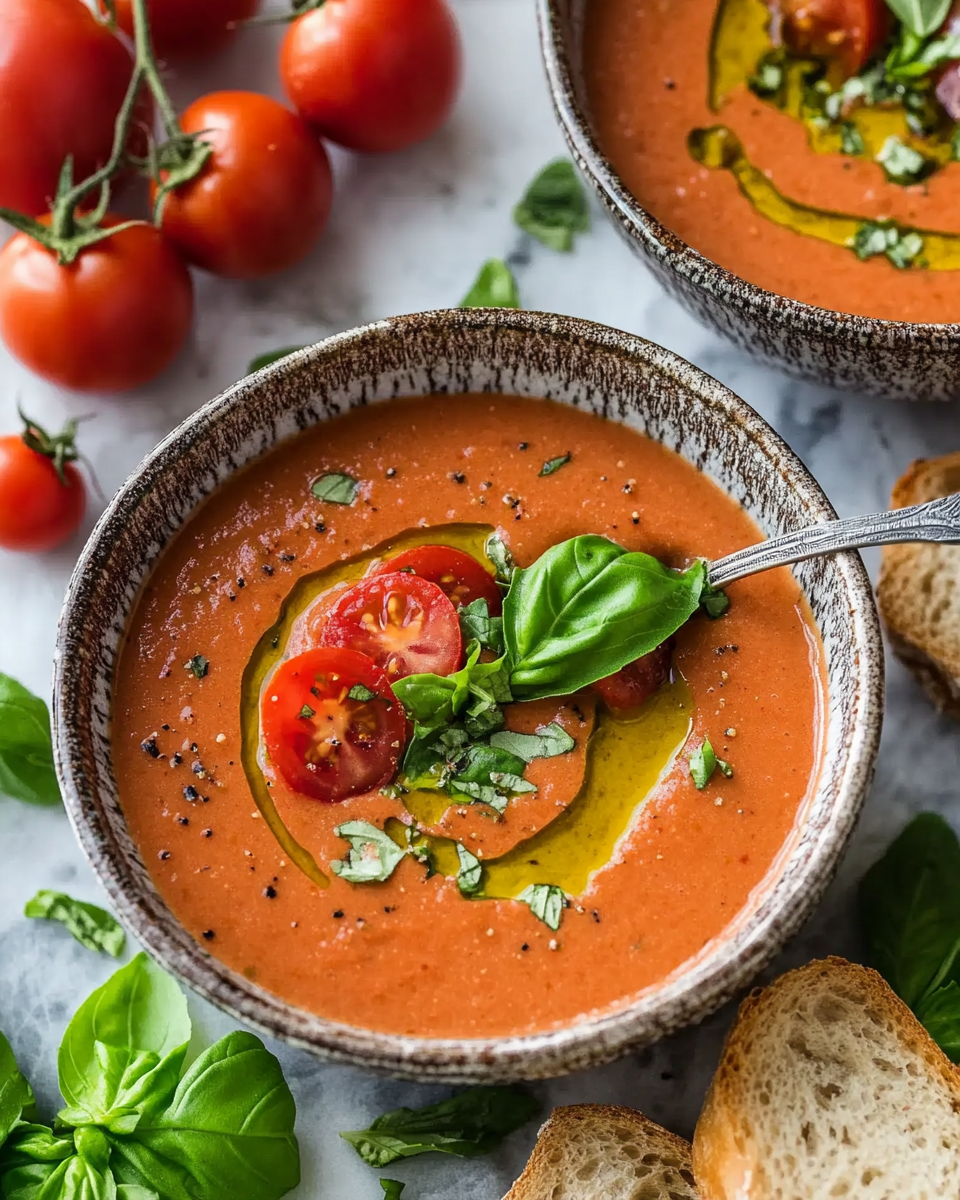Tomato Basil Gazpacho is a vibrant and refreshing cold soup that perfectly captures the essence of summer. Originating from Spain’s Andalusian region, this dish showcases the natural sweetness of ripe tomatoes combined with the aromatic freshness of basil. It’s a simple yet elegant recipe that requires no cooking, making it an ideal choice for hot days when you want something light, healthy, and full of flavor.
FULL RECIPE
Ingredients
- 6 ripe tomatoes, cored and chopped
- 1 red bell pepper, seeded and chopped
- 1 cucumber, peeled and chopped
- 1 small red onion, chopped
- 2 garlic cloves, minced
- 1/4 cup fresh basil leaves, chopped
- 3 tablespoons red wine vinegar
- 1/4 cup olive oil
- 1 teaspoon salt
- 1/2 teaspoon black pepper
- 1/2 teaspoon sugar (optional)
- 1 cup cold water
- Optional garnish: diced avocado, chopped basil, croutons
Directions
- In a large bowl, combine chopped tomatoes, bell pepper, cucumber, onion, and garlic.
- Add the basil, vinegar, olive oil, salt, pepper, sugar (if using), and cold water.
- Transfer the mixture to a blender or food processor and blend until smooth or desired consistency.
- Taste and adjust seasoning if needed.
- Refrigerate for at least 2 hours before serving to allow flavors to meld.
- Serve chilled, garnished with avocado, basil, or croutons if desired.
Nutritional Information
- Serving Size: 1 cup
- Calories: 120
- Total Fat: 9g
- Saturated Fat: 1.3g
- Cholesterol: 0mg
- Sodium: 310mg
- Total Carbohydrates: 10g
- Dietary Fiber: 2.5g
- Sugars: 6g
- Protein: 2g
- Vitamin A: 30% DV
- Vitamin C: 90% DV
- Calcium: 3% DV
- Iron: 6% DV
The Origins of Tomato Basil Gazpacho
Tomato Basil Gazpacho is a refreshing cold soup with roots in Spanish cuisine, particularly from the Andalusian region. Traditionally, gazpacho was a simple peasant dish, designed to use fresh, ripe vegetables during the hot summer months. Over time, it evolved into a sophisticated dish enjoyed worldwide. The addition of fresh basil gives this classic recipe a fragrant twist, marrying Mediterranean flavors in a way that appeals to both traditional and modern palates.
The Role of Tomatoes in Gazpacho
Tomatoes are the star ingredient in this gazpacho, providing a vibrant color and rich flavor base. They are naturally sweet and slightly tangy, which balances well with the acidity of vinegar and the peppery freshness of basil. Beyond flavor, tomatoes are packed with antioxidants, including lycopene, which is linked to numerous health benefits such as heart health and reduced cancer risk.
Why Fresh Basil is Essential
Basil adds an aromatic herbal note that elevates the soup from simple to complex. Fresh basil leaves release essential oils that enhance the depth of flavor. This herb not only adds taste but also offers anti-inflammatory and antibacterial properties, making it a flavorful and healthful addition to the gazpacho.
The Importance of Chilling Gazpacho
Gazpacho is traditionally served cold, which makes it a perfect dish for warm weather. Chilling the soup allows the flavors to meld and intensify, creating a more harmonious taste experience. Serving it cold also makes it incredibly refreshing and hydrating, a light meal or starter that cools the palate.
The Balance of Acid and Fat
The red wine vinegar and olive oil in the recipe provide a crucial balance. The vinegar adds brightness and tang, while the olive oil contributes smoothness and richness. This balance prevents the soup from tasting flat or one-dimensional, creating a creamy texture without dairy.
Health Benefits of Tomato Basil Gazpacho
This soup is low in calories and high in vitamins and antioxidants, making it a nutrient-dense choice. Tomatoes supply vitamin C and A, while cucumbers and peppers add hydration and fiber. Olive oil brings heart-healthy monounsaturated fats, supporting overall cardiovascular health. It’s also naturally gluten-free, vegan, and suitable for many dietary preferences.
Versatility as a Meal or Starter
Tomato Basil Gazpacho can be served as an appetizer, a light lunch, or even a side dish alongside grilled proteins. Its lightness makes it a great palate cleanser and a low-calorie option for those looking to enjoy fresh vegetables in a satisfying form. It also pairs beautifully with crusty bread or a crisp salad.
Customization and Variations
One of the great advantages of gazpacho is how easily it can be adapted. Some prefer a chunkier texture with diced vegetables stirred in, while others enjoy it silky smooth. Variations include adding fruits like watermelon or strawberries for sweetness, or a touch of heat with jalapeño or hot sauce. These tweaks allow the recipe to suit different tastes and occasions.
Cultural Significance and Popularity
Gazpacho has transcended its humble origins to become a beloved dish internationally. In Spain, it is a staple of summer dining, often served at family gatherings and festivals. Around the world, it’s appreciated in fine dining and home kitchens alike, celebrated for its simplicity, freshness, and health benefits.
Pairing Tomato Basil Gazpacho with Other Foods
This gazpacho pairs well with a variety of dishes. Light seafood such as shrimp or grilled fish complements its fresh flavors. It also works well with Mediterranean appetizers like olives, cheese, or tapas. When serving at a meal, consider contrasting the cold, fresh soup with warm, grilled items to create a balanced dining experience.
Seasonality and Ingredient Selection
The best gazpacho is made with peak-season tomatoes and fresh vegetables. Using ripe, juicy tomatoes and fresh basil leaves harvested at their prime results in the most flavorful soup. Off-season versions tend to lack the same vibrancy. Sourcing local, organic produce when possible further enhances the dish’s quality and sustainability.
Storage and Serving Tips
Gazpacho can be made ahead and stored in the refrigerator for up to three days, making it an excellent option for meal prep. Because it thickens when chilled, you may need to stir in a little cold water before serving to achieve the desired consistency. Serve it in small bowls or glasses, garnished with fresh herbs or a drizzle of olive oil for a polished presentation.
The Environmental Impact of Fresh Recipes Like Gazpacho
Eating fresh, plant-based recipes like tomato basil gazpacho can have a lower environmental footprint compared to meat-heavy meals. Utilizing seasonal, locally sourced produce reduces transportation emissions and supports sustainable farming practices. This makes gazpacho not only a healthy choice for individuals but a more eco-conscious choice for the planet.
Conclusion
Tomato Basil Gazpacho is more than just a cold soup — it’s a celebration of fresh, vibrant ingredients with deep cultural roots and modern appeal. Its combination of flavor, nutrition, and versatility makes it an excellent addition to any meal, especially during warmer months. Whether enjoyed as a simple starter or a light main, this gazpacho offers a delicious, healthy, and refreshing way to savor the best of summer’s bounty.






